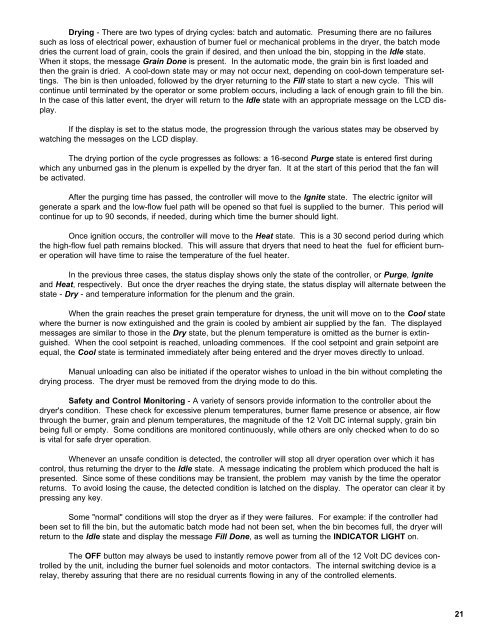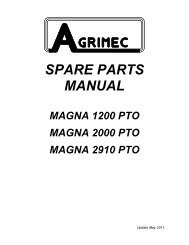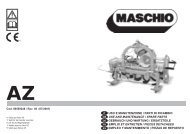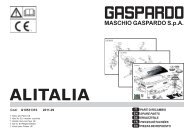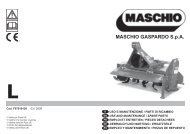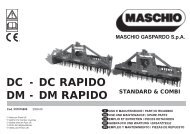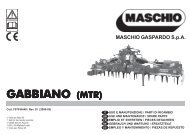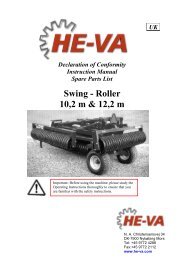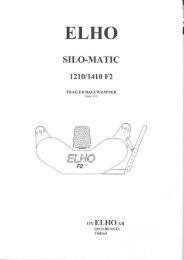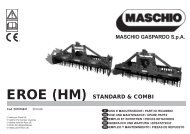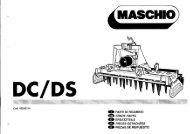GRAIN DRYER & PARTS BOOK - Opico
GRAIN DRYER & PARTS BOOK - Opico
GRAIN DRYER & PARTS BOOK - Opico
Create successful ePaper yourself
Turn your PDF publications into a flip-book with our unique Google optimized e-Paper software.
Drying - There are two types of drying cycles: batch and automatic. Presuming there are no failures<br />
such as loss of electrical power, exhaustion of burner fuel or mechanical problems in the dryer, the batch mode<br />
dries the current load of grain, cools the grain if desired, and then unload the bin, stopping in the Idle state.<br />
When it stops, the message Grain Done is present. In the automatic mode, the grain bin is first loaded and<br />
then the grain is dried. A cool-down state may or may not occur next, depending on cool-down temperature settings.<br />
The bin is then unloaded, followed by the dryer returning to the Fill state to start a new cycle. This will<br />
continue until terminated by the operator or some problem occurs, including a lack of enough grain to fill the bin.<br />
In the case of this latter event, the dryer will return to the Idle state with an appropriate message on the LCD display.<br />
If the display is set to the status mode, the progression through the various states may be observed by<br />
watching the messages on the LCD display.<br />
The drying portion of the cycle progresses as follows: a 16-second Purge state is entered first during<br />
which any unburned gas in the plenum is expelled by the dryer fan. It at the start of this period that the fan will<br />
be activated.<br />
After the purging time has passed, the controller will move to the Ignite state. The electric ignitor will<br />
generate a spark and the low-flow fuel path will be opened so that fuel is supplied to the burner. This period will<br />
continue for up to 90 seconds, if needed, during which time the burner should light.<br />
Once ignition occurs, the controller will move to the Heat state. This is a 30 second period during which<br />
the high-flow fuel path remains blocked. This will assure that dryers that need to heat the fuel for efficient burner<br />
operation will have time to raise the temperature of the fuel heater.<br />
In the previous three cases, the status display shows only the state of the controller, or Purge, Ignite<br />
and Heat, respectively. But once the dryer reaches the drying state, the status display will alternate between the<br />
state - Dry - and temperature information for the plenum and the grain.<br />
When the grain reaches the preset grain temperature for dryness, the unit will move on to the Cool state<br />
where the burner is now extinguished and the grain is cooled by ambient air supplied by the fan. The displayed<br />
messages are similar to those in the Dry state, but the plenum temperature is omitted as the burner is extinguished.<br />
When the cool setpoint is reached, unloading commences. If the cool setpoint and grain setpoint are<br />
equal, the Cool state is terminated immediately after being entered and the dryer moves directly to unload.<br />
Manual unloading can also be initiated if the operator wishes to unload in the bin without completing the<br />
drying process. The dryer must be removed from the drying mode to do this.<br />
Safety and Control Monitoring - A variety of sensors provide information to the controller about the<br />
dryer's condition. These check for excessive plenum temperatures, burner flame presence or absence, air flow<br />
through the burner, grain and plenum temperatures, the magnitude of the 12 Volt DC internal supply, grain bin<br />
being full or empty. Some conditions are monitored continuously, while others are only checked when to do so<br />
is vital for safe dryer operation.<br />
Whenever an unsafe condition is detected, the controller will stop all dryer operation over which it has<br />
control, thus returning the dryer to the Idle state. A message indicating the problem which produced the halt is<br />
presented. Since some of these conditions may be transient, the problem may vanish by the time the operator<br />
returns. To avoid losing the cause, the detected condition is latched on the display. The operator can clear it by<br />
pressing any key.<br />
Some "normal" conditions will stop the dryer as if they were failures. For example: if the controller had<br />
been set to fill the bin, but the automatic batch mode had not been set, when the bin becomes full, the dryer will<br />
return to the Idle state and display the message Fill Done, as well as turning the INDICATOR LIGHT on.<br />
The OFF button may always be used to instantly remove power from all of the 12 Volt DC devices controlled<br />
by the unit, including the burner fuel solenoids and motor contactors. The internal switching device is a<br />
relay, thereby assuring that there are no residual currents flowing in any of the controlled elements.<br />
21


